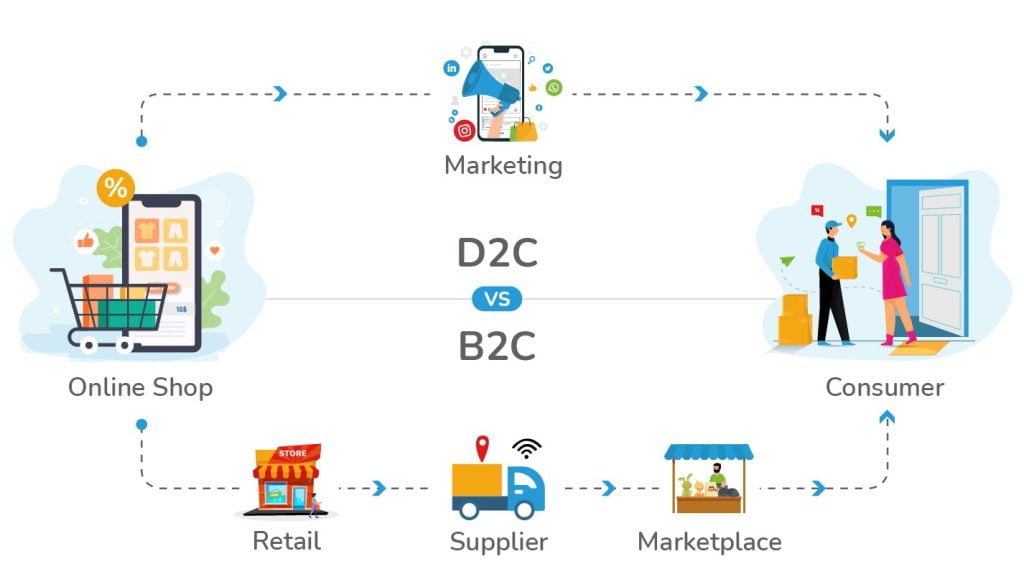The rapid augmentation of e-commerce has led to the popularization of two terms namely- D2C and B2C. Even though they may sound quite similar but there are significant differences between the two. In this article, you will get a thorough understanding of the “Difference between D2C and B2C business models.”

A Brief Overview
| S.No. | Differentiating Criteria | D2C | B2C |
| 1. | Business model | Direct to Consumer | Business to Consumer |
| 2. | Involvement of middlemen | No | Yes |
| 3. | Stages | Manufacturing Branding Marketing Websites Sales channels Consumer | Production Advertising Distributor Wholesaler Retailer Consumer |
| 4. | Prime Objective | – Building brand value – Lower pricing | – Low operational cost – Retailer relationship – Competitive edge |
| 5. | Customer Data | – Valuable customer insights – Buying habits of customers – Spending patternsSeasonal purchases | – No access to customer data – No information about the buyer’s journey |
| 6. | Duration of Sales Cycle | Shorter | Longer |
| 7. | Suitable for | – Personalized items – High-value goods – Electronics | – Consumables – Non-personalized items |
Detailed Comparison
As the name suggests D2C and B2C refer to “Direct to Consumer” and “Business to Consumer” respectively. B2C is a broad term of business where the manufacturer ultimately sells his products to the consumers either directly or indirectly. Firstly, the direct route of selling the products without any involvement of middlemen is called D2C. In contrast, the indirect route involves product dealing with the help of middlemen (merchants or retailers). Hence, the key difference is the absence and presence of middlemen. Thus, you can say that the D2C business model is a subset of B2C commerce. You will get a clear view through this picture and the table-

Business Model
- D2C– You might have heard the D2C advertisers saying “We don’t use middlemen.” Why so? Simply because their products reach consumers without any middle distribution channel! Their digital channels have a direct route. The service providers and manufacturers following the D2C business model have complete control over the selling process. Also, it helps D2C brands to effectively reach their target customers. All these features lead them to increase the ownership of the overall business.
- B2C– Unlike D2C, the middlemen play the most important role in the business model of B2C. “Middlemen” are the intermediaries who buy goods from producers or manufacturers and sell them to consumers.
Working Strategy
- D2C– Even though the selling of products and services directly to the end users sounds magical but it is equally complicated too! Every step of the D2C model needs partnership and coordination throughout the lifecycle and delivery processes of the product. Here comes the most important role of the internet and digital marketing system. However, the central principle of the D2C working strategy is to partner with different stakeholders of the “product & supply chain” of the region to connect the products directly with the target consumer. Especially for e-commerce growth, D2C businesses operate through online stores. Hence, they invest in effective R&D and innovative marketing strategies to establish strong connections with their customers. Also, they use customer data to have actionable insights.
- B2C– B2C is a kind of conventional business model wherein the products are shifted from factories to wholesalers and retailers, before finally delivering them to consumers. Hence, it involves price negotiations at every stage of product shifting. Since multiple agents are involved in the B2C business model, therefore, it significantly impacts the time taken to deliver the product to the end customer. It also affects the revenue model because the hierarchical movement of products to reach the end customer reduces the overall profit margins.
Third-Party Logistics (3PLs)
- D2C– D2C e-commerce is incomplete without 3PLs (third-party logistics). The 3PLs holds great significance because they provide prime services like warehousing, picking, packaging, and shipping of products. Eventually, the third-party logistics providers take responsibility for all the outbound logistics activities. Thus, they improve the scalability and performance of the business.
- B2C– B2C businesses do not need third-party logistics. Because they carry out product development and delivery by selling their products to merchants. Therefore, the merchants, wholesalers, and retailers are themselves responsible for logistics activities like warehouses, packaging, and shipping of products.
Examples
- D2C– boAt, Nykaa, Patanjali, MamaEarth, Amway, Bewakoof, Apple Inc., Puma, etc.
- B2C– Flipkart, Amazon, Spotify, Netflix, etc.
Benefits:
D2C Model
- Stronger relationships with the customers.
- Increased control over the sales, so, better profit margins.
- Higher profits
- Increase overall business agility.
B2C Model
- Multi-channel distribution
- Better scalability
- Low prices of the products
- Globalization because they reach large audiences.
Limitations
D2C Model
- Competition with retailers
- Management of order demand
- Brand perception
- Building brand value
- The pressure of converting the audience into customers
B2C Model
- Low-profit margins
- Higher dependency on intermediary agents (merchants and retailers).
- Long sales cycles.
Final Words
As you can see, both the business models i.e., D2C and B2C have different ways to connect with the customers. The former seeks to build a direct relationship with the customer while the latter focuses on expanding its customer base through multiple channels.
